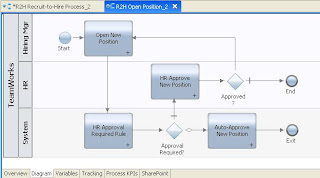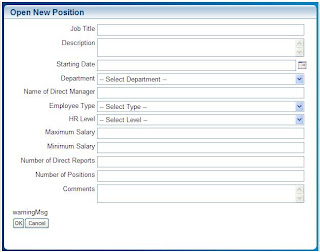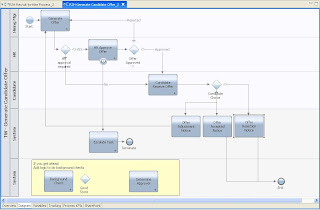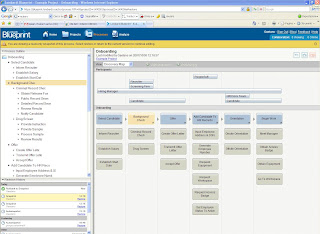
ci ritroveremo a gennaio 2008...

When evaluating software vendors, make sure that a Proof of Concept (POC) is part of your process. We just completed an intense vendor assessment between three BPMS (Business Process Management Suite) vendors. All three vendors have great products and plenty of successful customers. It wasn't until we entered the Proof of Concept phase when one of them separated from the pack.
In our POC we made the vendors start with a blank screen and build a sample process flow that we modeled on paper. We chose a model that exposed various features and functionalities of the BPMS tools. We where looking for ease of use, how quickly each vendor could complete the POC, and how the tools integrated with our existing .Net services.
What we found is that only one of the vendors could actually complete the POC in the one day event and that same vendor was the only one who could even figure out how to connect to our services. In fact, it was so easy for this vendor that we gave them additional services to connect to and they were able to accomplish that also.
The lesson learned here is you need to do more then just submit and analyze RFI's and RFP's. Vendor demos are not enough either. If we had not asked them to do a POC we would have selected a different vendor who could not easily integrate with our infrastructure. This would have raised our Total Cost of Ownership (TCO) and reduced our ability to improve speed to market.
When it is all said and done, the proof is in the pudding!


"" In his recent post, Neil Ward-Dutton talks about how WebMethods customers are doing traditional application development under the guise of Business Process Management. Folks, automating a business process is NOT business process management! Sandy Kemsley says "these customers are coming from the traditional EAI-type usage of webMethods." Yep. And, in summary, Neil says:
"Understand what, exactly, you want to do with BPM. Understand the key characteristics of the processes you're trying to improve, and equally importantly, who's driving the work—is it business people, IT people or both?
"Unfortunately, getting to the bottom of things is not as simple as saying 'I need a human-centric BPMS" or "I need an integration-centric BPMS'."
Neil, you've hit the nail on the head! And, indirectly, you raised the key difference between what used to be called "the pure-play vendors" (like my company, Lombardi) and the "stack vendors" (IBM, BEA, Tibco, WebMethods). I prefer to use the terms "new-BPM" and "old-AppDev" to describe the vendors, but however you slice it, the new-BPM tooling is directly targeted at enabling new levels of participation of business people alongside IT people in the solution scoping and development processes.
As you point out, that difference has nothing to do with "human-centric," "document-centric," or "integration-centric" but whether the user is approaching use of the BPMS as a new developer tool (with, for example, the semantics of BPEL), or as a way to change the way business and IT interact during solution development. This developer-centric vs. business-centric approach is the key difference in deciding what tools you will be successful with.
Our experience is that if a company uses a BPM tool in the same old way (IT application development owning all aspects of the project and the business expected to deliver a set of detailed requirements at the outset of the project) then the project will fail exactly as often as any traditional waterfall application development effort. Which is fairly often.
But if the customer wants to move to a new model for those processes owned by the business, with the business contributing people full-time to the solution development effort, then the new BPMS tools are effective at increasing success rates, lowering costs, and delivering better solutions. The new BPMS tooling by the focused BPM vendors is better at this, far better, than any of the tooling the stack vendors provide. The old-AppDev vendors provide tools for their target market... and that is not business people with moderate technical skills. In contrast, the new-BPM vendors are focused on providing tools for a new solution development model, one that promises increased participation by the business, while retaining full-control for IT. ""


I was hiking today up above Portland, Oregon at the Multnomah Falls. Spectacular. Except my damn knees. I started thinking about how I hear people say "gee, I wish I was
Oddly, this got me to thinking about business process management and about how almost everyone (except Lombardi, of course) has got it wrong. Most people think business process management is about Process. Wrong. Business process management is about people. Specifically, it is about making people more productive. People of diverse skills. People put in positions they might not be quite ready for. People retiring from their jobs. People starting their careers. Dear reader, if you are in a company with more than, say, 1,000 people, I wonder how many of those people do you think are perfectly suited to their jobs right now? How many have the perfect levels of skills, abilities, training and wisdom to do their jobs at peak efficiency right now? How many in your workgroup fit this description? I'm guessing you have people with different levels, some achieving the perfect blend you need, and some not.
Look, the point isn't that your organization needs help. In fact, the point is that your organization looks a lot like everyone else in this respect! Business process management should be thought of as a way to help teams work better. The team you have is the team you have, in many respects. You can't take the perfect team into the battle of competition tomorrow! You have to get a lot of the job done with the team you have. You might top-grade over time, and you might also lose some of your best people to promotions and their own career changes. The fact is, the people in your business have very different combinations of "perfection" at any given point in time. And in this globalized world, the question senior management asks is "how can I be most effective with what I have?" (A recent NY Times article quoted HP CEO Mark Hurd: "C.E.O.’s work on three things: strategy, operating models and people." Which, loosely translated I think means: what strategies can we pull off given our people, processes and customers?")
If workflow is the means by which we define behaviors, then the real advance of business process management is that it is the means by which we normalize how we measure behaviors and correlate those behaviors with the business results we achieve. Let me say it again: business process management is about how we measure people and correlate their activities with the business results they achieve.
In fact, practiced purely, I'd argue that it has nothing to do with how something gets done, only how well it gets done! It is today's evolutionary state of the most advanced de-centralized management capability. And by the way, if you don't get a grip on this issue - how to decentralize control of behavior while retaining insight into results - you will be run over by the people and technologies of the 21st century. Wiki's, blogs, SaaS word processors, SaaS spreadsheets, IM, Facebook (or Open Social) computing platforms... this all means you will have less control over the specific workflows, and more creativity than you ever thought possible. Your BPM initiative better be figuring out how you can deal with this... because these are becoming parts of the best processes in the world.
BPM helps you get a handle on the chaos that is real life, makes it explicit, and helps you manage around it. It does this by making the work explicit, linking that work to the reasons you are doing the work, and providing insight into the results. We call this trace-ability and it's key to doing business in the 21st century. It allows you to take the army you've got, and make them as effective as possible in executing against the strategy you've set.
As for me, there's direct traceability from the hike to my aching knees... time to take an Advil.
Phil Gilbert




 Iniziamo da questo post a pubblicare esempi di sistemi realizzati con Teamworks.
Iniziamo da questo post a pubblicare esempi di sistemi realizzati con Teamworks. a parte di un Hiring Manager per l’apertura di una nuova posizione. L’utente appartenente al gruppo Hiring Manager accede al portale digitando i propri username e password e compila una scheda in cui richiede la copertura di un determinato ruolo.
a parte di un Hiring Manager per l’apertura di una nuova posizione. L’utente appartenente al gruppo Hiring Manager accede al portale digitando i propri username e password e compila una scheda in cui richiede la copertura di un determinato ruolo. a nuova posizione è stata approvata inizia il processo di selezione del candidato. La divisione HR riceve la richiesta in base ai dati inseriti dall’Hiring Manager seleziona una lista di potenziali candidati fra cui scegliere e la invia all’Hiring Manager che deve valutare i candidati.
a nuova posizione è stata approvata inizia il processo di selezione del candidato. La divisione HR riceve la richiesta in base ai dati inseriti dall’Hiring Manager seleziona una lista di potenziali candidati fra cui scegliere e la invia all’Hiring Manager che deve valutare i candidati. giustamento delle condizioni, in questo caso gli verrà cuminicato che le sue richieste sono al vaglio dell?Hiring Manager, accettare l’offerta, o rifiutare. Come è ovvio negli ultimi due casi il sottoprocesso termina e gli viene notificato come e se procedere, nel primo invece le richieste del candidato vengono girate all’Hiring Manager e il processo riparte da quel punto.
giustamento delle condizioni, in questo caso gli verrà cuminicato che le sue richieste sono al vaglio dell?Hiring Manager, accettare l’offerta, o rifiutare. Come è ovvio negli ultimi due casi il sottoprocesso termina e gli viene notificato come e se procedere, nel primo invece le richieste del candidato vengono girate all’Hiring Manager e il processo riparte da quel punto.




Molte imprese hanno complesse strutture organizzative, le relazioni fra chi esegue una determinata attività e chi la deve approvare sono molto importanti. Non sempre però queste informazioni sono memorizzate nelle directory aziendali.
Il componente di TeamWorks 6, Organization Management consente di modellare l’organigramma aziendale (Process Organization Chart) con un modellatore grafico molto semplice da usare ma completo (si possono inserire anche le foto dei partecipanti) e soprattutto di mettere in relazione fra loro gli attori del processo.
I gruppi di partecipanti definiti in un singolo processo all’interno dell’ambiente di modellazione di TeamWorks, possono essere utilizzati in più processi, TeamWorks unisce il Process Organization Chart con i dati di analisi e aiuta così ad identificare e risolvere i problemi.
Inoltre l’organigramma permette di assegnare i task in base alle relazioni stabilite, ad esempio possiamo indirizzare un’attività al manager o al direttore di un determinato utente, possiamo definire gli skills degli utenti (o dei ruoli) e assegnarli agli utenti stessi e poi creare con semplicità regole di smistamento dei task in base agli skill posseduti dagli utenti.

 L'University College London Hospital Foundation (UCLH), UCLH è un trust di 6 strutture ospedaliere tutte localizzate nel West End di Londra, ha deciso di implementare un nuovo sistema di gestione delle cartelle cliniche dei pazienti utilizzando TeamWorks.
L'University College London Hospital Foundation (UCLH), UCLH è un trust di 6 strutture ospedaliere tutte localizzate nel West End di Londra, ha deciso di implementare un nuovo sistema di gestione delle cartelle cliniche dei pazienti utilizzando TeamWorks.Il nuovo sistema si è reso necessario per garantire il rispetto della regola delle ”18 settimane dalla visita al trattamento” che il governo inglese ha imposto a tutte le strutture ospedaliere.
Il nuovo sistema oltre a permettere un migliore e integrato trattamento delle informazioni relative ai pazienti, permetterà di identificare in anticipo i casi a rischio di non rispetto del target delle 18 settimane e aiutare a pianificare le risorse per raggiungere lo scopo.
Lo sviluppo del nuovo sistema avverrà in collaborazione di LogicaCMG e dovrà essere necessariamente in produzione per fine 2008.
Per il comunicato stampa cliccare qui.



"Le due società hanno annunciato un un accordo commerciale e marketing allo scopo di favorire e rafforzare l’interoperabilità delle rispettive soluzioni.
Da una parte Lombardi, principale fornitore di soluzioni per il business process management per le aziende del Global 2000, dall’altra Mega, leader mondiale nelle soluzioni di enterprise architecture: insieme, le due società hanno annunciato un accordo per favorire e rafforzare l’interoperabilità delle loro soluzioni, Teamworks e Mega Suite. Puntando a un’interoperabilità dei processi, le due piattaforme d’offerta consentiranno ai clienti di riutilizzare il loro investimento nella modellazione dei processi in Mega, importandoli direttamente in Teamworks, per eseguirli, gestirli e ottimizzarli.
Secondo i due portavoce aziendali, l’obiettivo comune è quello di aiutare le aziende a orientare la loro attività in funzione dei processi. In particolare, Lombardi TeamWorks è il software leader nel Bpm per il design, l’esecuzione e il miglioramento dei processi mentre le soluzioni Enterprise Architecture (Ea) di Mega aiutano a ridurre i rischi, gestire il cambiamento e migliorare l’efficienza identificando le best practice, valutando gli impatti potenziali di differenti scenari ed accelerando i progetti grazie alla possibilità di riutilizzare le informazioni strategiche. Il repository proposto da Mega permette ai manager di consultare, gestire ed ottimizzare i processi e l’architettura d’impresa.
Mega e Lombardi sono membri dell’Object Management Group, il consorzio mondiale dedicato alla produzione di specifiche e di standard. Le due società hanno partecipato alla redazione della Business Process Modeling Notation e delle specifiche per il Business Process Definition Metamodel, attualmente in attesa dell’approvazione dell’Omg.
 MEGA e LOMBARDI sono membri dell’Object Management Group, il consorzio mondiale dedicato alla produzione di specifiche e di standard. Le due società hanno partecipato alla redazione della Business Process Modeling Notation (BPMN), e delle specifiche per il Business Process Definition Metamodel.
MEGA e LOMBARDI sono membri dell’Object Management Group, il consorzio mondiale dedicato alla produzione di specifiche e di standard. Le due società hanno partecipato alla redazione della Business Process Modeling Notation (BPMN), e delle specifiche per il Business Process Definition Metamodel.
 Il BPM Discovery è sicuramente una delle attività più delicate nel processo di utilizzo di tecniche BPM.
Il BPM Discovery è sicuramente una delle attività più delicate nel processo di utilizzo di tecniche BPM.







For over 60 years, AIIM (The Association for Information and Image Management)
has been the leading international organization focused on helping users to understand the challenges associated with managing documents, content, and business processes. AIIM is international in scope, independent, implementation-focused, and, as the representative of the entire ECM industry — including users, suppliers, and the channel — acts as the industry's intermediary. [ visit www.aiim.org ]
The Association of Business Process Management Professionals is a non-profit, vendor independent professional organization dedicated to the advancement of business process management concepts and its practices. ABPMP is practitioner-oriented and
practitioner-led. [ visit www.abpmp.org ]
The BPM Institute is a peer-to-peer exchange for business process management professionals and is hosted by BrainStorm Group, a trusted source of unbiased information and education on BPM, Workflow, and Integration-related issues since 1997. The BPM Institute has been established in response to the demand for education and peer exchange on all aspects surrounding business process computing.
[ visit www.BPMinstitute.org ]
BPM Today provides IT professionals with daily news and information about business process management issues. Topics include data analytics, sales automation, employee relations, supply chain, resource planning, and more. BPM Today is part of the Newsfactor Network. [ visit www.bpm-today.com ]
BPM.com provides news and in-depth articles about both the business and technology perspectives of business process management. [ visit www.bpm.com ]
Business Integration Journal covers the software solutions that enable the successful execution of business processes. These solutions have emerged from the convergence of many technologies: EAI, workflow, enterprise applications, collaborative tools, integration brokers, Web services, application servers, development tools, rules engines, and commerce offerings. In addition, the website features all the latest breaking news in the market and arranges content intuitively by topic. [ visit www.bijonline.com ]
The Business Process Management Group (founded in 1992) is a global business club exchanging ideas and best practice in business process and change management. The organization includes over 12,000 members across all business sectors. Through case studies, seminars and research, BPMG supports its members in improving their organizations work across business processes, information technology, and people.
[ visit www.bpmg.org ]
BPMI.org (the Business Process Management Initiative) is a non-profit corporation that aims to empower companies of all sizes, across all industries, to develop and operate business processes that span multiple applications and business partners, behind the firewall and over the Internet. BPMI's core objective is to promote and develop open, complete, and royalty free XML-based standards that support and enable business process management (BPM) in all industries.
Working with standards organizations including OMG, WfMC, and OASIS, BPMI.org focuses on developing standards to support the entire life-cycle of BPM — from process design to deployment, execution, maintenance, and optimization. [ visit www.bpmi.org ]
BPTrends is the primary source of business intelligence for the global community of business executives and process change practitioners focused on Business Process Management. Industry thought leaders provide news, analysis, and opinion on trends, directions, and best practices relating to all aspects of business process change, including strategy, architecture, redesign, automation, and human performance. BPTrends is the most comprehensive, in-depth business process information site devoted to educating and informing the market, urging managers to look at the full range of business process opportunities and solutions available. [ visit www.bptrends.com ]
OMG is an open membership, non-profit consortium that produces and maintains computer industry specifications for interoperable enterprise applications. Model Driven Architecture (MDA) is OMG's multi-platform flagship specification based on the modeling specifications Meta-Object Facility (MOF), Unified Modeling Language (UML), XMI, and Common Warehouse Metamodel (CWM). OMG's middleware platform, CORBA, includes the Interface Definition Language (IDL) and the IIOP protocol. [ visit www.omg.org ]
OASIS is an international, non-profit consortium that drives the development, convergence, and adoption of e-business standards. OASIS produces more web services standards than any other organization along with standards for security, e-business, the public sector, and numerous application-specific markets.
Founded in 1993, OASIS has more than 4,000 participants representing over 600 organizations and individual members in 100 countries. [ visit www.oasis-open.org ]
The charter of the Workflow And Reengineering International Association is to identify and clarify issues that are common to users of workflow, electronic commerce and those who are in the process of reengineering their organizations. The association facilitates opportunities for members to discuss and share their experiences freely.
Established in 1992, WARIA's mission is to make sense of what's happening at the intersection of Business Process Management, Workflow and Electronic Commerce and reach clarity through sharing experiences, product evaluations, networking between users and vendors, education and training. [ visit www.waria.com ]
The Workflow Management Coalition (WfMC), founded in August 1993, is a non-profit, international organization of analysts, researchnalysts, research groups, universities, workflow vendors, and users.
WfMC's mission is to promote and develop the use of workflow through the establishment of standards for software terminology, interoperability, and connectivity between workflow products. The primary standards body for the workflow software market, WfMC promotes the use of workflow by establishing industry standards for software terminology, interoperability, and connectivity between workflow products.
[ visit www.wfmc.org ]
The World Wide Web Consortium develops interoperable technologies (specifications, guidelines, software, and tools) to lead the Web to its full potential. W3C is a forum for information, commerce, communication, and collective understanding.
[ visit www.w3.org ]